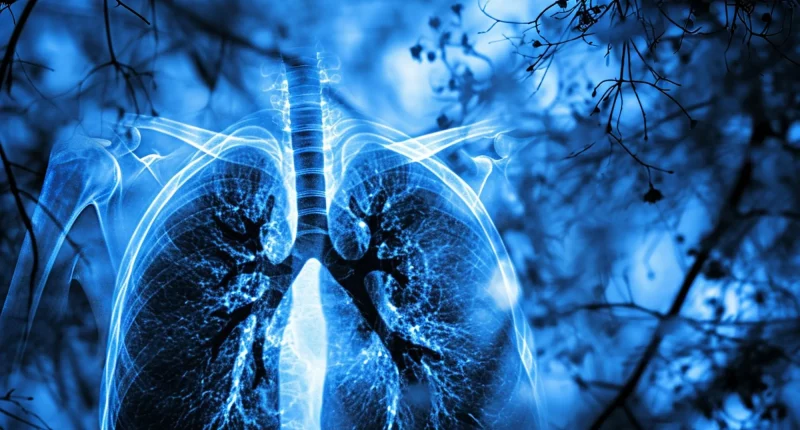A bronchial carcinoid tumor is an uncommon type of lung cancer that originates in the neuroendocrine cells of the lungs. These tumors are usually slow-growing and are often identified in the central area of the lungs, particularly in the bronchi, which are the main airways leading into the lungs.
Despite their slow growth, they can be problematic if they block airways or spread to other areas of the body. Treatment options usually include surgery, and in some cases, chemotherapy or radiation therapy may be necessary.
Symptoms
Symptoms of bronchial carcinoid tumors often grow gradually and can be mistaken for other respiratory conditions. One of the primary symptoms is a persistent cough that doesn’t improve over time.
Patients may also experience shortness of breath and wheezing, which can occur due to the tumor partially blocking the airways. Hemoptysis, or coughing up blood, is another significant symptom that can be alarming for patients.
Additionally, some individuals may report chest pain or a sensation of chest tightness, further contributing to respiratory distress.
In some cases, bronchial carcinoid tumors can lead to more systemic symptoms. These include recurrent lung infections like pneumonia, caused by the blockage of the airways. Some individuals might also experience symptoms related to carcinoid syndrome, a condition where the tumor secretes hormones into the bloodstream.
This can result in facial flushing, diarrhea, wheezing, and a quick heart rate. Early diagnosis and treatment are crucial to managing symptoms and preventing complications linked with these tumors.
Treatment
The main treatment for bronchial carcinoid tumors is surgical removal, which is often effective given the usually slow-growing nature of these tumors. Surgery may involve removing a portion of the lung, like in a lobectomy, or a more localized procedure if the tumor is smaller and confined to a specific area.
In many cases, surgery can completely eliminate the tumor, particularly if it is identified early before significant spread. Minimally invasive surgical techniques, such as video-assisted thoracoscopic surgery, are increasingly used to decrease recovery time and complications.
In cases where surgery is not feasible due to the tumor’s size, location, or the patient’s overall health, other treatments may be considered. Chemotherapy and radiation therapy are generally less effective for bronchial carcinoid tumors compared to other types of lung cancer, but they can be used in particular situations. For patients with metastatic disease or those experiencing symptoms from hormone secretion, targeted therapies and medications like somatostatin analogs can help manage symptoms and control tumor growth. A multidisciplinary approach involving oncologists, pulmonologists, and thoracic surgeons is often necessary to tailor the best treatment plan for every patient.
Causes
The exact cause of bronchial carcinoid tumors is not fully understood, but several factors are believed to contribute to their development. Genetic mutations play a significant role, with changes in certain genes leading to the abnormal growth of neuroendocrine cells in the lungs. While most bronchial carcinoid tumors occur sporadically, there is a hereditary component in some cases, with familial history increasing the risk. Research suggests that individuals with particularly inherited conditions, such as multiple endocrine neoplasia type 1 (MEN1), are more prone to developing these tumors.
Environmental factors might also contribute to the risk of developing bronchial carcinoid tumors, though their impact is less clear compared to other lung cancers. Unlike many lung cancers, smoking is not strongly linked to bronchial carcinoid tumors, although it might still play a minor role.
Exposure to environmental pollutants, such as industrial chemicals or radiation, could potentially increase the chance, but more research is needed to establish a direct connection. Overall, the interplay between genetic predispositions and environmental exposures is complex, and ongoing studies aim to better understand the mechanisms behind these rare tumors.
Complications
Complications of bronchial carcinoid tumors may include:
- Airway Obstruction: Tumors can obstruct airways, leading to difficulty breathing, coughing, or respiratory infections.
- Recurrent Lung Infections: Obstruction or impaired lung function can result in frequent bronchitis or pneumonia.
- Carcinoid Syndrome: Some tumors secrete hormones that cause symptoms like facial flushing, diarrhea, and wheezing.
- Metastasis: Although less common, tumors can spread to other areas of the body, complicating treatment and affecting prognosis.
- Bleeding: Tumors can cause bleeding in the lungs, leading to hemoptysis (coughing up blood).
- Surgical Risks: Complications from surgery, like infection or prolonged recovery, can arise, especially in more invasive procedures.
Diagnosis
Diagnosing bronchial carcinoid tumors usually involves a combination of imaging studies, laboratory tests, and biopsy procedures. Initially, a healthcare provider may suspect a bronchial carcinoid tumor based on a patient’s symptoms and a thorough physical examination.
Imaging techniques such as chest X-rays and computed tomography scans are commonly used to find any abnormal masses or lesions in the lungs. Positron emission tomography (PET) scans can also help in detecting active tumors and assessing their spread to other parts of the body.
Once an abnormality is identified, further testing is needed to confirm the diagnosis. Bronchoscopy is a key diagnostic tool where a thin, flexible tube with a camera is inserted through the nose or mouth into the airways, allowing direct visualization of the tumor and the opportunity to collect tissue samples. A biopsy, obtained through bronchoscopy or needle aspiration, provides a definitive diagnosis by enabling microscopic examination of the tumor cells. In addition, laboratory tests measuring levels of certain hormones or markers in the blood can support the diagnosis, especially in cases where the tumor is secreting bioactive substances. Accurate diagnosis is crucial for developing an effective treatment plan tailored to the patient’s specific condition.
Prevention
Preventing bronchial carcinoid tumors can be challenging due to their unclear causes, but certain measures may help reduce the risk:
- Avoid Tobacco Smoke: Refrain from smoking and avoid exposure to secondhand smoke, as smoking might still have a minor role in developing lung-related conditions.
- Limit Exposure to Environmental Pollutants: Avoid exposure to industrial chemicals, radiation, and other environmental pollutants that could potentially increase cancer risk.
- Healthy Lifestyle: Maintain a healthy diet, exercise regularly, and manage stress to support overall immune function and decrease cancer risks.
- Regular Medical Checkups: Regular health screenings and checkups can assist detect early signs of abnormal growths or conditions.
- Genetic Counseling: For individuals with a family history of neuroendocrine tumors or genetic conditions like multiple endocrine neoplasia type 1, genetic counseling and testing can help assess risk and guide preventive measures.
- Awareness of Symptoms: Stay informed about the symptoms of bronchial carcinoid tumors and get medical advice promptly if any persistent respiratory symptoms occur.
Summary
Bronchial carcinoid tumors are uncommon, slow-growing lung cancers that originate in neuroendocrine cells, causing symptoms like persistent cough, wheezing, and hemoptysis. Diagnosis involves imaging, bronchoscopy, and biopsy to confirm the presence and extent of the tumor.
Treatment primarily involves surgical removal, with other therapies used as needed. The exact causes are unclear, but genetic mutations and possibly environmental factors contribute. Preventive measures include avoiding tobacco smoke, reducing exposure to pollutants, maintaining a healthy lifestyle, regular checkups, genetic counseling, and awareness of symptoms. Early detection and treatment are crucial for effective management.









